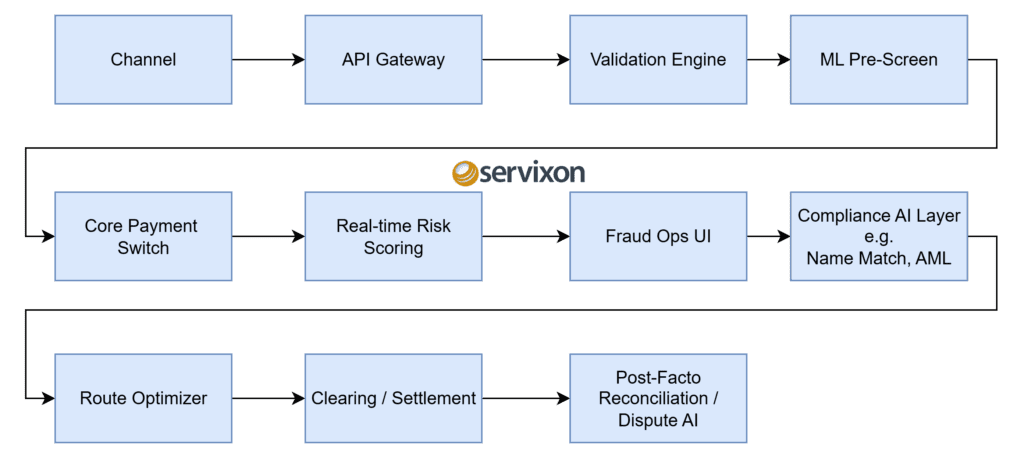In today’s real-time, high-volume, ISO 20022-compliant payment ecosystems, the concept of Payment Integrity is no longer a back-office concern. It’s now a frontline operational requirement — especially in systems powering Faster Payments (FPS), SWIFT GPI, SEPA, and mobile money transfers.
Whether you’re building a core banking platform, a BaaS layer, or a cross-border gateway, maintaining payment integrity involves more than preventing fraud; it’s about ensuring correctness, authorization, non-repudiation, reconciliation accuracy, and compliance across an increasingly fragmented transaction lifecycle.
So, how exactly can AI/ML be used to enforce and elevate payment integrity?
What Payment Integrity Really Means
| Area | Common Integrity Failures |
|---|---|
| Payment Construction | Incorrect IBAN, currency mismatch, duplicate messages |
| Authorization | Invalid mandates, compromised credentials |
| Routing & Switching | Incorrect BICs, network misroutings, STP failures |
| Execution | Timing violations (cut-offs), fee miscalculations |
| Reconciliation | Settlement mismatches, partial postings |
| Compliance | Sanctions misses, false negatives/positives in screening |
Payment Integrity refers to the enforcement of correctness across these fault zones in real-time or near-real-time, particularly at scale.
Where AI/ML Actually Adds Value in Payment Integrity
1. Data Validation & Enrichment (Pre-Initiation)
- Problem: Upstream systems send malformed or incomplete messages (e.g., missing mandatory fields in ISO 20022
pain.001orpacs.008). - AI/ML Use
- Use ML models to auto-fill likely values from historical data (e.g., missing BICs or fee codes).
- NLP for smart parsing of free-text remittance info.
- Predictively flag transactions likely to bounce due to field quality issues.
2. Dynamic Routing Validation
- Problem: Incorrect or outdated routing tables can misdirect payments, causing SLA violations.
- AI/ML Use
- Reinforcement learning to optimize routing decisions based on success/failure history.
- Graph-based models to evaluate the best payment corridors (e.g., for cross-border GPI flows).
- Predict routing changes based on geopolitical or liquidity changes.
3. Reconciliation and Duplicate Detection
- Problem: Same transaction message (especially
pacs.008) processed twice due to retries, middleware issues, or HA failover races. - AI/ML Use
- Anomaly detection on transaction hashes, timing windows, and originator systems.
- Use fuzzy matching + sequence models to detect near-duplicates (slightly different timestamps, references).
- Auto-reconciliation engines are powered by supervised ML classifiers trained on exception categories.
4. Compliance Screening and Pattern Evasion
- Problem: Sanction evasion via
- Typo-squatting in beneficiary names (e.g., “Mikhael Ivanov” vs. “Mikhail Ivanov”)
- Use of shell entities or intermediaries
- AI/ML Use
- Use embeddings and NLP models (e.g., BERT-based) for smarter name/entity resolution.
- Graph AI to detect indirect relationships across multi-hop payments.
- Continuous learning from the regulator and OFAC list updates.
5. Non-repudiation and Authorization Assurance
- Problem: Forged mandates or credentials used to initiate payments.
- AI/ML Use
- Behavioral biometrics models for validating login/device/payment behavior.
- Session anomaly detection, such as unusual login-IP-patterns, user-agent mismatches.
- Predict unauthorized behavior based on cohort risk scoring.
Real Implementation Architecture: Where Does ML Plug In?

Each of these is powered by models running in microservices or stream processors (e.g., Apache Flink, Kafka Streams) to ensure low-latency inference (<50ms).
Model Types You Should Actually Use
| Use Case | Model Type |
|---|---|
| Duplicate detection | Sequence matching + cosine similarity (Siamese Networks) |
| Fraud pattern detection | Isolation Forest / Deep SVDD / Autoencoders |
| Name & sanctions matching | Transformer-based NLP models (BERT, RoBERTa) |
| Routing optimization | Reinforcement Learning (Q-learning, DQN) |
| Mandate fraud | Time-series LSTM + anomaly scoring |
| Smart reconciliation | Gradient boosting + feature engineering (payer/payee, amount, hash, FX rate) |
Training Data and Feedback Loop
To build these systems
- Use ISO 20022/MT message logs, transaction metadata, and user session logs
- Incorporate human feedback from fraud analysts, dispute handlers, and compliance teams
- Continuously retrain with
- New labels (e.g., “false positive sanction match”)
- New entity relationships from external sources
- Updated rules from regulators
Metrics That Matter
If you’re implementing AI for payment integrity, measure
- False positive rate in fraud and sanction screening
- Percentage of payment STP failures avoided
- Time to resolve duplicate or disputed payments
- Prediction accuracy for routing success
- Risk score changes versus new fraud cases
Sample Python [Duplicate Detector]
from sklearn.feature_extraction.text import TfidfVectorizer
from sklearn.metrics.pairwise import cosine_similarity
# Simulated payment data
payments = [
"Transfer to John Doe, IBAN: DE89370400440532013000, EUR 1000.00",
"Transfer to Jon Doe, IBAN: DE89370400440532013000, $1000",
"Payment to vendor ABC for invoice INV-4021",
"Invoice INV-4021 paid to vendor ABC",
"Salary for March - David",
"March Salary David"
]
# Generate TF-IDF matrix
vectorizer = TfidfVectorizer().fit_transform(payments)
cosine_sim_matrix = cosine_similarity(vectorizer)
# Detect duplicates based on threshold
threshold = 0.85
print("Possible Duplicate Payment Pairs:")
for i in range(len(payments)):
for j in range(i + 1, len(payments)):
score = cosine_sim_matrix[i][j]
if score >= threshold:
print(f"[{score:.2f}] {payments[i]} ↔ {payments[j]}")
Output Samples
Possible Duplicate Payment Pairs:
[0.91] Transfer to John Doe, IBAN: DE89370400440532013000, USD 1000.00 ↔ Transfer to Jon Doe, IBAN: DE89370400440532013000, $1000
[0.89] Payment to vendor ABC for invoice INV-4021 ↔ Invoice INV-4021 paid to vendor ABC
[0.86] Salary for March - David↔ March Salary DavidYou can extend this by including transaction metadata such as amount, date, payer/payee hashes, etc., and feed it into a Siamese LSTM or transformer encoder for richer embeddings.
Summary
Payment integrity is not just a compliance checkbox; it’s a core performance indicator of any payment platform. AI and ML enable not just real-time error/fraud prevention but proactive optimization and resilience across the full payment lifecycle.
In high-stakes environments like BaaS, ISO 20022 core banking rails, and instant payments, this is not a luxury; it’s mandatory. If your platform isn’t using AI for payment integrity today, it’s not ready for what tomorrow brings.











